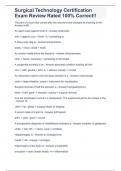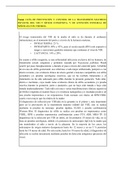A congenit - Study guides, Class notes & Summaries
Looking for the best study guides, study notes and summaries about A congenit? On this page you'll find 21 study documents about A congenit.
Page 2 out of 21 results
Sort by
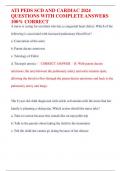
-
ATI PEDS SCD AND CARDIAC 2024 QUESTIONS WITH COMPLETE ANSWERS 100% CORRECT
- Exam (elaborations) • 5 pages • 2024
-
Available in package deal
-
- $13.49
- + learn more
A nurse is caring for an infant who has a congenital heart defect. Which of the following is associated with increased pulmonary blood flow? a. Coarctation of the aorta b. Patent ductus arteriosus c. Tetralogy of Fallot d. Tricuspis atresia - CORRECT ANSWER B. With patent ductus arteriosus, the area between the pulmonary artery and aorta remains open, allowing the blood to flow through the patent ductus arteriosus and back to the pulmonary artery and lungs. The 8 year old child diag...
Surgical Technology Certification Exam Review Rated 100% Correct!!
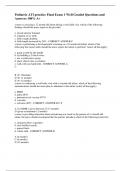
-
Pediatric ATI practice Final Exam 1 Well Graded Questions and Answers 100% A+
- Exam (elaborations) • 8 pages • 2023
-
- $8.49
- + learn more
Pediatric ATI practice Final Exam 1 Well Graded Questions and Answers 100% A+ a nurse is assessing a 12 month old infant during a well child visit. which of the following findings should the nurse report to the provider a. closed anterior fontanel b. eruption of six teeth c. birth weight doubled d. birth length increased by 50% - CORRECT ANSWER-C a nurse is performing a developmental screening on a 10 month old infant. which of the following fine motor skills should the nurse expect t...
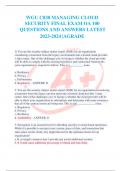
-
1. Describe how your body responds to an infection.: T cells produce cy-tokines, which stimulate B cells. B cells produce antibodies. 2. Identify role of DNA changes in congenital abnormalities.: Mutations ingenes or chromosomal abnormalities 3. How does
- Exam (elaborations) • 36 pages • 2024
-
- $20.99
- + learn more
1. Describe how your body responds to an infection.: T cells produce cy-tokines, which stimulate B cells. B cells produce antibodies. 2. Identify role of DNA changes in congenital abnormalities.: Mutations ingenes or chromosomal abnormalities 3. How does development disrupts congenital abnormalities?: Alterations ofDNA 4. Describes factors that disrupt homeostasis and how disruptions affectwellbeing.: (ex) Fluid and electrolyte shifts can cause n/v or dysrhythmias. 5. Explain RAAS: Renin-a...

-
1. Describe how your body responds to an infection.: T cells produce cy-tokines, which stimulate B cells. B cells produce antibodies. 2. Identify role of DNA changes in congenital abnormalities.: Mutations ingenes or chromosomal abnormalities 3. How does
- Exam (elaborations) • 22 pages • 2024
-
- $30.99
- + learn more
1. Describe how your body responds to an infection.: T cells produce cy-tokines, which stimulate B cells. B cells produce antibodies. 2. Identify role of DNA changes in congenital abnormalities.: Mutations ingenes or chromosomal abnormalities 3. How does development disrupts congenital abnormalities?: Alterations ofDNA 4. Describes factors that disrupt homeostasis and how disruptions affectwellbeing.: (ex) Fluid and electrolyte shifts can cause n/v or dysrhythmias. 5. Explain RAAS: Renin-a...

-
1. Describe how your body responds to an infection.: T cells produce cy-tokines, which stimulate B cells. B cells produce antibodies. 2. Identify role of DNA changes in congenital abnormalities.: Mutations ingenes or chromosomal abnormalities 3. How does
- Exam (elaborations) • 809 pages • 2024
-
- $35.99
- + learn more
1. Describe how your body responds to an infection.: T cells produce cy-tokines, which stimulate B cells. B cells produce antibodies. 2. Identify role of DNA changes in congenital abnormalities.: Mutations ingenes or chromosomal abnormalities 3. How does development disrupts congenital abnormalities?: Alterations ofDNA 4. Describes factors that disrupt homeostasis and how disruptions affectwellbeing.: (ex) Fluid and electrolyte shifts can cause n/v or dysrhythmias. 5. Explain RAAS: Renin-a...

-
1. Describe how your body responds to an infection.: T cells produce cy-tokines, which stimulate B cells. B cells produce antibodies. 2. Identify role of DNA changes in congenital abnormalities.: Mutations ingenes or chromosomal abnormalities 3. How does
- Exam (elaborations) • 15 pages • 2024
-
- $20.99
- + learn more
1. Describe how your body responds to an infection.: T cells produce cy-tokines, which stimulate B cells. B cells produce antibodies. 2. Identify role of DNA changes in congenital abnormalities.: Mutations ingenes or chromosomal abnormalities 3. How does development disrupts congenital abnormalities?: Alterations ofDNA 4. Describes factors that disrupt homeostasis and how disruptions affectwellbeing.: (ex) Fluid and electrolyte shifts can cause n/v or dysrhythmias. 5. Explain RAAS: Renin-a...
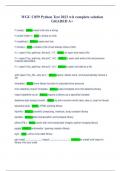
-
1. Describe how your body responds to an infection.: T cells produce cy-tokines, which stimulate B cells. B cells produce antibodies. 2. Identify role of DNA changes in congenital abnormalities.: Mutations ingenes or chromosomal abnormalities 3. How does
- Exam (elaborations) • 3 pages • 2024
-
- $39.99
- + learn more
1. Describe how your body responds to an infection.: T cells produce cy-tokines, which stimulate B cells. B cells produce antibodies. 2. Identify role of DNA changes in congenital abnormalities.: Mutations ingenes or chromosomal abnormalities 3. How does development disrupts congenital abnormalities?: Alterations ofDNA 4. Describes factors that disrupt homeostasis and how disruptions affectwellbeing.: (ex) Fluid and electrolyte shifts can cause n/v or dysrhythmias. 5. Explain RAAS: Renin-a...
RESUMEN CHARLA GUIA PRACTICA CLINICA VIH SIFILIS CONGENITA.
Espero, te sirva! El documento fue hecho con mucho esfuerzo. Atte Fatima O.

Do you wonder why so many students wear nice clothes, have money to spare and enjoy tons of free time? Well, they sell on Stuvia! Imagine your study notes being downloaded a dozen times for $15 each. Every. Single. Day. Discover all about earning on Stuvia

